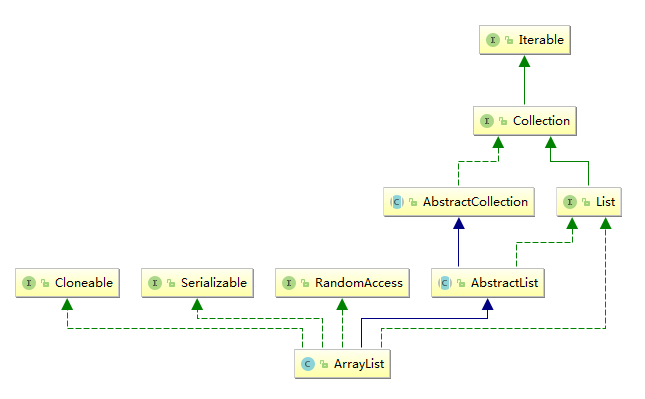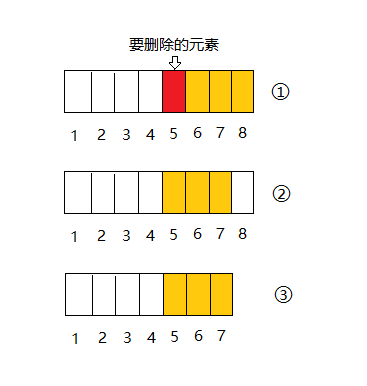ArrayList 源码分析
本篇文章基于Java版本:
1.8.0_91,代码中的注释不止是翻译,还带有一些自己的理解
点左侧目录按钮,可以查看本文目录
一、ArrayList类结构层次图

public class ArrayList<E> extends AbstractList<E> implements List<E>, RandomAccess, Cloneable, java.io.SerializableArrayList继承AbstractList和实现了RandomAccess。对于支持随机访问的数据存储,可以继承AbstractList,而RandomAccess是一个标记接口,表名实现这个接口的集合,是支持快速随机访问的,官方还说,实现该接口的集合,使用for循环的方式获取数据for (int i=0, n=list.size(); i < n; i++)会优于用迭代器获取数据for (Iterator i=list.iterator(); i.hasNext();),该接口是Java集合框架的成员之一。
二、属性
/** * 初始化默认容量。 * Default initial capacity. */private static final int DEFAULT_CAPACITY = 10;/** * 指定该ArrayList容量为0时,返回该空数组。 * Shared empty array instance used for empty instances. */private static final Object[] EMPTY_ELEMENTDATA = {};/** * 当调用无参构造方法,返回的是该数组。刚创建一个ArrayList 时,其内数据量为0。 * 它与EMPTY_ELEMENTDATA的区别就是:该数组是默认返回的,而后者是在用户指定容量为0时返回。 * * Shared empty array instance used for default sized empty instances. We * distinguish this from EMPTY_ELEMENTDATA to know how much to inflate when * first element is added. */private static final Object[] DEFAULTCAPACITY_EMPTY_ELEMENTDATA = {};/** * 保存添加到ArrayList中的元素。 * ArrayList的容量就是该数组的长度。 * 该值为DEFAULTCAPACITY_EMPTY_ELEMENTDATA 时,当第一次添加元素进入ArrayList中时,数组将扩容值DEFAULT_CAPACITY。 * * The array buffer into which the elements of the ArrayList are stored. * The capacity of the ArrayList is the length of this array buffer. Any * empty ArrayList with elementData == DEFAULTCAPACITY_EMPTY_ELEMENTDATA * will be expanded to DEFAULT_CAPACITY when the first element is added. */transient Object[] elementData; // non-private to simplify nested class access/** * ArrayList的实际大小(数组包含的元素个数)。 * The size of the ArrayList (the number of elements it contains). * * @serial */private int size;需要注意的是elementData的访问权限是transient,ArrayList自定义了它的序列化(writeObject(java.io.ObjectOutputStream s))和反序列化(readObject(java.io.ObjectOutputStream s))方式。
三、构造方法
ArrayList(int initialCapacity)
/** * 根据指定的初始化容量构造一个空列表 * Constructs an empty list with the specified initial capacity. * * @param initialCapacity the initial capacity of the list ArrayList的指定初始化容量 * @throws IllegalArgumentException if the specified initial capacity * is negative 如果ArrayList的指定初始化容量为负。 */public ArrayList(int initialCapacity) { if (initialCapacity > 0) { this.elementData = new Object[initialCapacity]; } else if (initialCapacity == 0) { this.elementData = EMPTY_ELEMENTDATA; } else { throw new IllegalArgumentException("Illegal Capacity: "+ initialCapacity); }}
ArrayList()
/** * 构造一个初始容量为 10 的空列表。 * Constructs an empty list with an initial capacity of ten. */public ArrayList() { this.elementData = DEFAULTCAPACITY_EMPTY_ELEMENTDATA;}
ArrayList(Collection<? extends E> c)
/** * 构造一个包含指定 collection 的元素的列表, * 这些元素是按照该 collection 的迭代器返回它们的顺序排列的。 * * Constructs a list containing the elements of the specified * collection, in the order they are returned by the collection's * iterator. * * @param c the collection whose elements are to be placed into this list * 其元素将放置在此列表中的 collection * @throws NullPointerException if the specified collection is null * 如果指定的 collection 为空 */public ArrayList(Collection<? extends E> c) { elementData = c.toArray(); if ((size = elementData.length) != 0) { // c.toArray might (incorrectly) not return Object[] (see 6260652) // c.toArray 返回类型不一定是Object[] if (elementData.getClass() != Object[].class) elementData = Arrays.copyOf(elementData, size, Object[].class); } else { // replace with empty array. this.elementData = EMPTY_ELEMENTDATA; }}使用Collection.toArray()方法,返回类型不一定是Object[],所以多加了一个判断,使用Arrays.copyOf(elementData, size, Object[].class)进行了转换。
四、核心方法

时间复杂度:O(1) 操作的数量为常数,与输入的数据的规模(n)无关。 O(n) 输入数据的规模(n)与操作的数量成正比。
4.1 get(int index)
/** * 返回list中索引为index的元素 * Returns the element at the specified position in this list. * * @param index index of the element to return * 需要返回的元素的索引 * @return the element at the specified position in this list * list中索引为index的元素 * @throws IndexOutOfBoundsException {@inheritDoc} */public E get(int index) { //越界检查 rangeCheck(index); //返回索引为index的元素 return elementData(index);}越界检查:
/** * 检查给出的索引index是否越界。 * 如果越界,抛出运行时异常。 * 这个方法并不检查index是否为负数: * 如果下标为负数,它总是在访问数组之后立刻抛出 ArrayIndexOutOfBoundsException * * Checks if the given index is in range. If not, throws an appropriate * runtime exception. This method does *not* check if the index is * negative: It is always used immediately prior to an array access, * which throws an ArrayIndexOutOfBoundsException if index is negative. */private void rangeCheck(int index) { if (index >= size) throw new IndexOutOfBoundsException(outOfBoundsMsg(index));}/** * 构造下标越界异常的详细信息。 * Constructs an IndexOutOfBoundsException detail message. * Of the many possible refactorings of the error handling code, * this "outlining" performs best with both server and client VMs. */private String outOfBoundsMsg(int index) { return "Index: "+index+", Size: "+size;}返回索引为index的元素
E elementData(int index) { return (E) elementData[index];}4.2 add(E e)
/** * 添加元素到list末尾。 * Appends the specified element to the end of this list. * * @param e element to be appended to this list * 被添加的元素 * @return <tt>true</tt> (as specified by {@link Collection#add}) */public boolean add(E e) { //空间检查、扩容 ensureCapacityInternal(size + 1); // Increments modCount!! //插入元素 elementData[size++] = e; return true;}空间检查
//minCapacity 想要的最小容量private void ensureCapacityInternal(int minCapacity) { //当数组列表为空时 if (elementData == DEFAULTCAPACITY_EMPTY_ELEMENTDATA) { //这里之所以用Math.max(),考虑到兼容addAll()方法 minCapacity = Math.max(DEFAULT_CAPACITY, minCapacity); } ensureExplicitCapacity(minCapacity);}private void ensureExplicitCapacity(int minCapacity) { // 更改次数+1 modCount++; // overflow-conscious code // 这个判断是多余的,因为入参minCapacity总是大于elementData.length(见下图) if (minCapacity - elementData.length > 0) //扩容 grow(minCapacity);}

扩容
/** * 分派给arrays的最大容量 * 某些VM会在数组中保留一些头字。 * 尝试分配这个最大存储容量,可能会导致array容量大于VM的limit,最终导致OutOfMemoryError。 * * The maximum size of array to allocate. * Some VMs reserve some header words in an array. * Attempts to allocate larger arrays may result in * OutOfMemoryError: Requested array size exceeds VM limit */private static final int MAX_ARRAY_SIZE = Integer.MAX_VALUE - 8;/** * 扩容,保证ArrayList至少能存储minCapacity个元素。 * * Increases the capacity to ensure that it can hold at least the * number of elements specified by the minimum capacity argument. * * @param minCapacity the desired minimum capacity * 想要的最小容量 */private void grow(int minCapacity) { // overflow-conscious code int oldCapacity = elementData.length; /** * 扩容。第一次扩容为:在原有的容量基础上增加一半。 * 第一次扩容后,如果容量还是小于minCapacity,就将容量扩充为minCapacity。 * 如果扩容后的容量大于临界值,则进行大容量分配。 */ int newCapacity = oldCapacity + (oldCapacity >> 1); if (newCapacity - minCapacity < 0) newCapacity = minCapacity; if (newCapacity - MAX_ARRAY_SIZE > 0) newCapacity = hugeCapacity(minCapacity); // minCapacity is usually close to size, so this is a win: // 想要的最小容量(minCapacity)通常接近于数组列表的长度(见上图),所以下边的方式比较好 elementData = Arrays.copyOf(elementData, newCapacity);}/** * 进行大容量分配:将容量扩大为Integer.MAX_VALUE */private static int hugeCapacity(int minCapacity) { if (minCapacity < 0) // overflow throw new OutOfMemoryError(); return (minCapacity > MAX_ARRAY_SIZE) ? Integer.MAX_VALUE : MAX_ARRAY_SIZE;}可以看出ArrayList的最大元素个数为Integer.MAX_VALUE(2^31-1=2147483647);每次扩容时,使用Arrays.copyOf()方法,把旧数组copy到新数组里,所以使用ArrayList时,尽量避免数据的扩容。
4.3 add(int index, E element)
/** * 在列表中的指定位置插入元素。 * 当前位置的元素和index之后的元素向后移一位(下标加1)。 * * Inserts the specified element at the specified position in this * list. Shifts the element currently at that position (if any) and * any subsequent elements to the right (adds one to their indices). * * @param index index at which the specified element is to be inserted * 插入元素的位置 * @param element element to be inserted * 要插入的元素 * @throws IndexOutOfBoundsException {@inheritDoc} */public void add(int index, E element) { //越界检查 rangeCheckForAdd(index); //空间检查、扩容 ensureCapacityInternal(size + 1); // Increments modCount!! //对数组进行复制处理,目的就是空出index的位置插入element,并将index后的元素位移一个位置 System.arraycopy(elementData, index, elementData, index + 1, size - index); //将元素插入到index位置,并把实际容量+1 elementData[index] = element; size++;}越界检查
/** * 越界检查的另一个版本,用在add()和addAll()方法 * A version of rangeCheck used by add and addAll. */private void rangeCheckForAdd(int index) { if (index > size || index < 0) throw new IndexOutOfBoundsException(outOfBoundsMsg(index));}空间检查、扩容
和4.2 add(E e) 中的空间检查、扩容方法一样。
数组复制:arraycopy
System.arraycopy(Object src, int srcPos, Object dest, int destPos, int length)
/** * 该方法用于从指定源数组中进行拷贝操作,可以指定开始位置,拷贝指定长度的元素到指定目标数组中 * * @param src the source array. 源数组(要复制到目标数组中) * @param srcPos starting position in the source array. 源数组中的起始位置 * @param dest the destination array. 目标数组 * @param destPos starting position in the destination data. 目标数组中的起始位置 * @param length the number of array elements to be copied. 源数组中要复制的长度 */public static native void arraycopy(Object src, int srcPos, Object dest, int destPos, int length);使用native关键词修饰的方法,称为Java Native Interface(Java本地接口)。
4.4 remove(int index)
/** * 删除list中位置为指定索引index的元素。 * 索引之后的元素向左移一位 * * Removes the element at the specified position in this list. * Shifts any subsequent elements to the left (subtracts one from their * indices). * * @param index the index of the element to be removed * @return the element that was removed from the list * 被删除的元素 * @throws IndexOutOfBoundsException {@inheritDoc} */public E remove(int index) { //检查索引是否越界 rangeCheck(index); modCount++; E oldValue = elementData(index); //删除指定元素后,需要左移的元素个数 int numMoved = size - index - 1; //2 如果有需要左移的元素,就移动(移动后,该删除的元素就已经被覆盖了) if (numMoved > 0) System.arraycopy(elementData, index+1, elementData, index, numMoved); //3 为了让GC起作用,必须显式的为最后一个位置赋null值 elementData[--size] = null; // clear to let GC do its work return oldValue;}remove(int index)方法中,如果删除的元素不是最后一个元素,则进行copy,如下图:

4.5 set(int index, E element)
/** * 替换指定索引的元素 * Replaces the element at the specified position in this list with * the specified element. * * @param index index of the element to replace * @param element element to be stored at the specified position * @return the element previously at the specified position * @throws IndexOutOfBoundsException {@inheritDoc} */public E set(int index, E element) { //检查索引是否越界 rangeCheck(index); //记录被替换的元素 E oldValue = elementData(index); //替换元素 elementData[index] = element; //返回被替换的元素 return oldValue;}
五、其他方法
5.1 remove(Object o)
/** * 删除list中第一次出现的指定元素(如果存在)。 * 如果不存在,则不改变该集合。 * 更正式的说,是移除索引最小的指定元素(如果存在)。 * 返回true:如果集合包含被移除的元素(或者相当于,集合被改变了) * * @param o 被移除的元素 * @return <tt>true</tt> 如果集合包含被移除的元素 */public boolean remove(Object o) { if (o == null) { for (int index = 0; index < size; index++) if (elementData[index] == null) { //快速删除指定索引的元素 fastRemove(index); return true; } } else { for (int index = 0; index < size; index++) if (o.equals(elementData[index])) { //快速删除指定索引的元素 fastRemove(index); return true; } } return false;}
快速删除指定索引的元素
/* * 忽略越界检查并且不返回被删除元素的私有方法。 */private void fastRemove(int index) { modCount++; int numMoved = size - index - 1; if (numMoved > 0) //数组复制 System.arraycopy(elementData, index+1, elementData, index, numMoved); //为了让GC起作用,必须显式的为最后一个位置赋null值 elementData[--size] = null; // clear to let GC do its work}删除的原理见上图
5.2 clear()
/** * 移除集合中所有的元素,调用此方法后集合会被置空。 */public void clear() { modCount++; // clear to let GC do its work 为了让GC起作用 for (int i = 0; i < size; i++) elementData[i] = null; size = 0;}使用for循环置空集合中的每个元素
5.3 addAll(Collection<? extends E> c)
/** * 按照指定集合的迭代器返回元素的顺序,将指定集合中的所有元素追加到列表的末尾。 * * @param c 被添加到列表中的集合 * @return <tt>true</tt> if this list changed as a result of the call * @throws NullPointerException if the specified collection is null */public boolean addAll(Collection<? extends E> c) { //返回包含此集合中所有元素的数组 Object[] a = c.toArray(); int numNew = a.length; //空间检查、扩容 ensureCapacityInternal(size + numNew); // Increments modCount //把指定集合转化后的数组复制到elementData中(追加到末尾) System.arraycopy(a, 0, elementData, size, numNew); size += numNew; return numNew != 0;}addAll()会把指定集合中的所有元素追加到列表的末尾。
5.4 addAll(int index, Collection<? extends E> c)
/** * 从指定位置,按照指定集合的迭代器返回元素的顺序, * 将指定集合中的所有元素追加到列表的末尾。 * @param index 集合中第一个元素 将插入到列表中的索引为index的位置 * @param c 被添加到列表中的集合 */public boolean addAll(int index, Collection<? extends E> c) { //越界检查 size - index >= 0 rangeCheckForAdd(index); //返回包含此集合中所有元素的数组 Object[] a = c.toArray(); int numNew = a.length; //空间检查、扩容 ensureCapacityInternal(size + numNew); // Increments modCount int numMoved = size - index; //如果不是插入到末尾 if (numMoved > 0) //把index到末尾的元素复制到index + numNew后 System.arraycopy(elementData, index, elementData, index + numNew, numMoved); System.arraycopy(a, 0, elementData, index, numNew); size += numNew; return numNew != 0;}5.5 retainAll(Collection<?> c)
/** * 仅保留该列表中包含在指定集合中的元素。 * 换句话说,从这个列表中删除指定集合中不包含的所有元素。 * >>保留两个集合中的交集 * * @param c 包含要保留在此列表中的元素的集合 * @return {@code true} 如果列表因调用此方法而改变,则返回true */public boolean retainAll(Collection<?> c) { //判断不为空 Objects.requireNonNull(c); //批量移除 return batchRemove(c, true);}批量移除或保存batchRemove()
/** * 私有方法。用来批量移除或保存 * @return 如果列表因调用此方法而改变,则返回true */private boolean batchRemove(Collection<?> c, boolean complement) { final Object[] elementData = this.elementData; int r = 0, w = 0; boolean modified = false; try { for (; r < size; r++) if (c.contains(elementData[r]) == complement) elementData[w++] = elementData[r]; } finally { // 即使c.contains()异常时,也能保持与AbstractCollection行为的兼容。 if (r != size) { System.arraycopy(elementData, r, elementData, w, size - r); w += size - r; } if (w != size) { // 为了让GC起作用,手动置空 for (int i = w; i < size; i++) elementData[i] = null; modCount += size - w; size = w; modified = true; } } return modified;}当c.contains()异常时,finally中把没来得及用contains比较的元素,与比较后elementData[w]的元素放一起,把剩余的空位置置空,让GC回收。
5.6 removeAll(Collection<?> c)
/** * 从这个列表中删除指定集合中包含的所有元素。 * * @param c 包含要从列表中删除的元素的集合 * @return {@code true} 如果列表因调用此方法而改变,则返回true */public boolean removeAll(Collection<?> c) { //判断不为空 Objects.requireNonNull(c); //批量删除 return batchRemove(c, false);}batchRemove(c, false)见【5.5 批量移除或保存batchRemove()】,通过控制布尔值complement达到了删除或保存的功能,方法抽象的套路只能学习。
重温ArrayList源码,发现了之前没注意到的点。编程就像写文章一样,首先需要多读别人怎么写代码,然后思考消化,变成自己的。
站在巨人的肩膀上,走的更远,共勉!
可以留言说下你阅读源码的感受,你的评论、在看、转发,都能让我高兴好久。
版权声明: 本文为 InfoQ 作者【读钓】的原创文章。
原文链接:【http://xie.infoq.cn/article/dfcc51cd311dad8c745c1d3a9】。文章转载请联系作者。
读钓
Java开发,专心练剑 2017.11.10 加入
公众号:读钓的YY,欢迎关注









评论